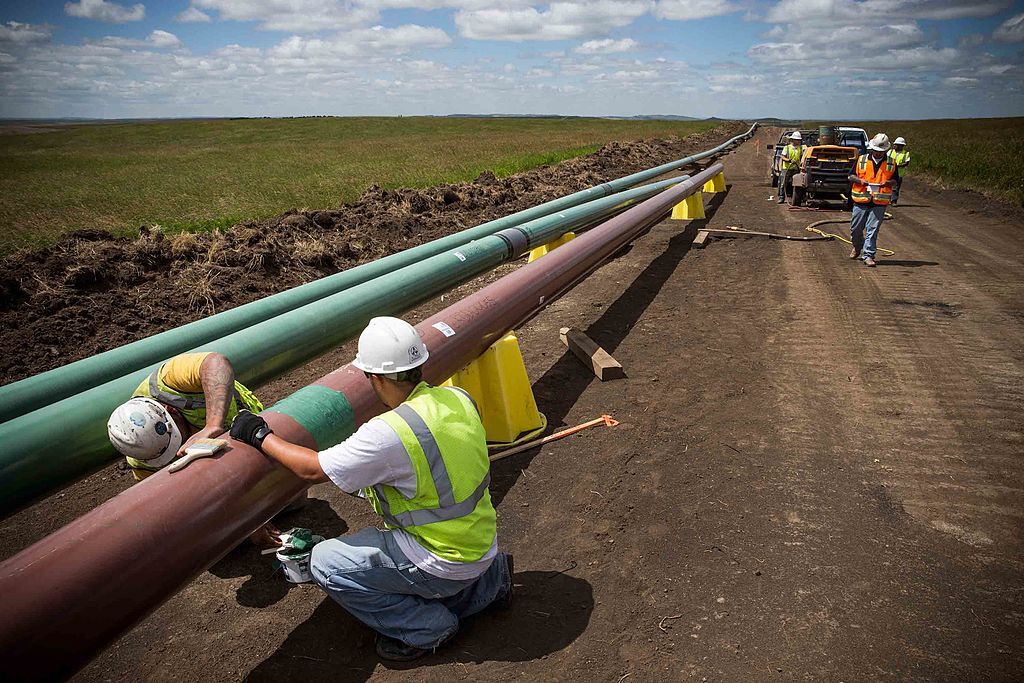(Andrew Burton/Getty Images)
Carbon capture and sequestration (CCS) is a process where supercritical carbon dioxide (1070+ psi and 88 degrees Fahrenheit) is injected into Class VI injection wells, into underground subsurface rock formations to a depth of at least 5,000 feet. The CO2 gas fills pore spaces located within these formations.
Recently, Ohio’s legislators introduced bills HB 170 and SB 136, which will give the Ohio Department of Natural Resources (ODNR) primacy (primary control) over Ohio’s Class VI carbon dioxide injection wells. Currently, the U.S. EPA has control and issues the permits for Class VI wells.
H.B. 170 and S.B. 136 will allow the ODNR chief to force non-consenting property owners to surrender use of the “pore space” under their private property.
“A storage operator who has obtained the consent of owners of at least 70 percent of the pore space proposed to be used in a storage facility may submit a statutory consolidation application for the operation of the entire proposed storage facility to the chief of the division of oil and gas resources management,” H.B. 170 states.
Private landowners have no rights or the ability to stop this dangerous asphyxiant from being stored under their homes.
CCS does not remove any existing carbon dioxide from the atmosphere but rather captures carbon dioxide from industrial processes, including ethanol fermentation, methane reforming, Portland cement production, and emissions from fossil fuel power plants. The process is energy intensive and expensive. The CCS equipment can require up to 30% of the energy that a power plant produces.
A recent report by the International Panel on Climate Change found “the levelized costs of electricity (LCOEs) for thermal power generation with CCS are at least 1.5 to 2 times above current alternatives, which include renewable energy plus storage.”
In addition to increased electricity bills, taxpayers will be picking up the costs for the 45Q tax credits for carbon dioxide captured. The Inflation Reduction Act established rates per ton of CO2 sequestered at $85 per ton. Considering that a large coal power plant emits 15 million tons of CO2 per year; the subsidy would be $1.25 billion in taxpayer dollars per year for one power plant.
SUPPORT: YOU MAKE OUR WORK POSSIBLE
There are many concerns about safety throughout the entire process, including the toxic chemicals needed to sequester the CO2 gas, the pipelines used to transport the gas, and issues with Class VI wells leaking CO2 gas. Some estimates say at least 900 miles of pipelines would be required to carry CO2 across the state from sources to injection wells in eastern Ohio.
In 2020, the Mississippi town of Satartia experienced a pipeline rupture in a 24-inch pipe. The pipe spewed out CO2 at a pressure of 1300 psi for more than three hours. The accident resulted in 200 people being evacuated and 45 taken to the hospital, with many having resulting chronic illnesses.
Nearby cars shut off or failed to start because of lack of oxygen needed to operate internal combustion engines. Carbon dioxide gas is odorless, colorless, doesn’t burn, is heavier than air. It is also an asphyxiant and intoxicant, which makes releases from CO2 pipelines harder to observe and avoid especially when it spreads and migrates off the pipeline right-of-way.
In 2009, concerned citizens living in Darke County successfully mobilized over a 14-month period to stop a proposed carbon sequestration project.
“The 35-member Midwest Regional Carbon Sequestration Project (MRCSP) cancelled the $92.8 million dollar proposal to inject one million tons of carbon dioxide captured over four years from an ethanol plant in Greenville, Ohio,” according to a report from Recharge News.
There is no guarantee that the CO2 will remain in the rock strata in perpetuity. Several factors could contribute to leaking of the super-critical CO2 gas from the underground storage locations. One of these is seismic activity.
“The presence of seismic activity, both natural and induced, is of great importance when evaluating CO2 sequestration potential. Extensive fault zones may provide leakage pathways along which CO2 could migrate,” according to a study published in Environmental Geosciences.
Additionally, the very act of injecting high-pressure CO2 into continental crusts could induce earthquakes and jeopardize carbon storage.
“Deep borehole stress measurements at the Mountaineer coal-burning power plant on the Ohio River in West Virginia indicate a severe limitation on the rate at which CO2 could be injected without the resulting pressure build-up, initiating slip on preexisting faults,” according to a study published in the Proceedings of the National Academy of Sciences of the United States of America.
The fact that Ohio has over 36,000 orphan oil wells also adds to the risks of injecting high pressure CO2 into Ohio’s Appalachian counties.
Finally, current CCS projects have shown that the process fails to capture the promised amounts of CO2 and many of the taxpayer subsidized projects have been terminated.
According to the Geoengineering Monitor, after decades of research, “there is no evidence that CCS can address the causes of the climate crisis or significantly reduce greenhouse gas emissions.”
CCS is too risky and too expensive.
SUPPORT: YOU MAKE OUR WORK POSSIBLE
Read the full article here


